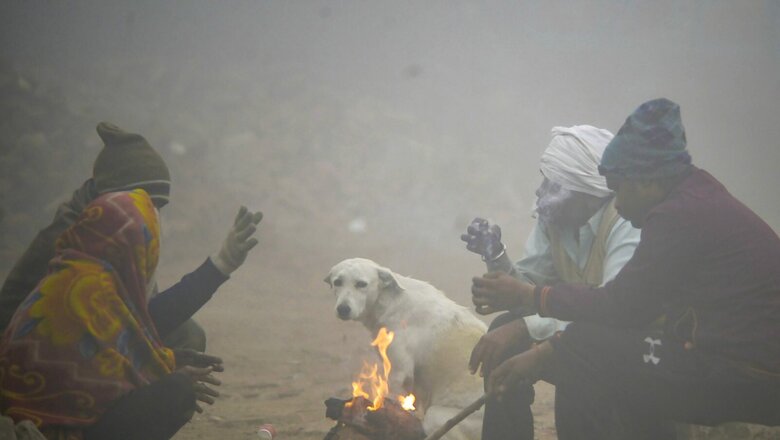
views
Weather News Updates: Delhi recorded minimum temperature at 1.4 degrees Celsius, season’s lowest, on Monday morning as freezing cold winds from Himalayas push down mercury in Northern India. The Indian Meteorological Department has predicted that temperature is likely to dip further until western disturbances provide some relief, starting Thursday.
IMD prediction on Sunday said that Delhi-NCR is likely to again experience a cold wave this week with the minimum temperature expected to be around 3 degrees Celsius.
Track Latest Weather Updates here:
-Weather Forecast for Bengaluru and Neighbouring Areas:
Mainly clear sky is predicted over Bengaluru and neighbouring areas for the next 24 hours. “Shallow to moderate fog/mist very likely during early morning hours in some areas. Maximum and minimum temperature very likely to be around 30 and 13 degrees Celsius respectively,” a weather bulletin said.
Karnataka’s Bagalkote and Chamarajanagara (Hardanahalli KVK) meanwhile recorded the lowest minimum temperature of 9.4 degrees Celsius in the plains of the state, meteorological centre said.
-Massive Landslide in Ramban, Traffic Movement Halted on Jammu-Srinagar Highway
Traffic movement has been halted on Jammu-Srinagar highway after a massive landslide in Panthyal, Ramban, in which a steel tunnel has reportedly been damaged completely.
-Mercury Goes Below Zero in Parts of Rajasthan
As per IMD figures, Rajasthan’s Churu has recorded -2.5 degrees Celsius and Sikar recorded -2 degrees Celsius. Hisar in Haryana, meanwhile, registered 0.8 degrees Celsius.
-Delhi Records Minimum Temp at 1.4 Deg C
Delhi has recorded minimum temperature of 1.4 degrees Celsius, data on Monday morning showed. The national capital recorded a cold morning on Sunday too with the minimum temperature settling at 4.7 degrees Celsius, three notches below the season’s average. The relative humidity recorded at 8:30 am was 74 per cent on Sunday.
Delhi shivers as Lodhi Road records a minimum temperature of 1.6 degrees Celsius while Safdarjung records a 1.4 degrees Celsius minimum temperature today, as per the IMD. (Representational image) pic.twitter.com/giOJXMWfyD
— ANI (@ANI) January 16, 2023
-Orange Alert for Cold Wave in Delhi
IMD had earlier issued an orange warning for cold wave in Delhi till January 17-18. Delhi saw an intense cold wave spell from January 5 to January 9, the second longest in the month in a decade, according to IMD data. It has also recorded over 50 hours of dense fog this month so far, which is the highest since 2019.
-When is Cold Wave Declared
In the plains, a cold wave is declared if the minimum temperature dips to 4 degrees Celsius or when it is 10 degrees Celsius and 4.5 notches below normal.
A severe cold wave is when the minimum temperature dips to two degrees Celsius or the departure from the normal limits is by more than 6.4 notches.
-Schools Shut in Rajasthan’s Udaipur
All schools in Rajasthan’s Udaipur will remain closed till January 18 for students up to Class 8 in wake of cold wave conditions. Private schools will remain open from 9 am to 3 pm from January 19 to 22.
-Trains Delayed Due to Fog: Indian Railways

-Rajasthan Reeled Under Sub 5 Degree Celsius temp
At minus 4.7 degrees Celsius, Fatehpur in Sikar district of Rajasthan recorded the lowest minimum temperature over the plains of northwest India. Punjab’s Faridkot shivered at minus one degree Celsius.
The Met Office said cold wave to severe cold wave conditions prevailed in parts of Punjab, Rajasthan, Haryana, Delhi and west Madhya Pradesh on Sunday.
Many parts of northwest and southeast Rajasthan recorded a minimum temperature in the range of 1 to 3 degrees Celsius. Parts of Punjab, Haryana, Delhi and southwest Uttar Pradesh recorded their minimum temperature in the range of 3 to 5 degrees Celsius, it said.
Churu, located near the Thar desert, recorded the season’s lowest minimum temperature of minus 2.5 degrees Celsius, according to the data available on the India Meteorological Department (IMD) website.
-Delhi Witnesses Second Longest Cold Wave in a Decade
Delhi saw an intense cold wave spell from January 5 to January 9, the second longest in the month in a decade, according to the IMD data.
It has also recorded over 50 hours of dense fog this month so far, which is the highest since 2019.
-Punjab Records 1.6 degrees Celsius
In Punjab, Amritsar recorded a minimum of 1.6 degrees Celsius. Ludhiana, Patiala, Pathankot, Bathinda and Gurdaspur experienced cold weather conditions at 4.9, 4.2, 8, 1 and 3.7 degrees Celsius respectively.
Union Territory Chandigarh, the common capital of Punjab and Haryana, recorded 6.7 degrees Celsius.
Minimum temperatures have fallen by 4-7 degrees Celsius over Punjab, Haryana, Delhi, east Rajasthan, west Uttar Pradesh and northwest Madhya Pradesh, the IMD said in a statement, adding there was no significant change in the remaining parts of northwest India.
-Severe Cold Wave Between January 17 & 18
The weather bureau said minimum temperatures are likely to fall further by about 2 degrees Celsius over many parts of northwest and central India till January 17-18 and cold wave to severe cold wave conditions are very likely over many parts of Rajasthan, Punjab and Haryana, and Delhi during this period.
“Ground Frost likely at isolated places over Himachal Pradesh, Punjab, Haryana and Rajasthan from January 16 to 18,” it said.
-Kashmir Settles Below Freezing Point
Night temperatures in most places of Kashmir settled below the freezing point even as the weather office has forecast a further dip in the minimum temperature over the next few days in view of dry weather Srinagar recorded a low of minus 0.6 degrees Celsius on Saturday night – half a degree down from the night before, they said.
The minimum in Kupwara, a frontier district, settled at minus 1.3 degrees Celsius, the officials said.
Pahalgam in Anantnag district registered a low of minus 10.9 degrees Celsius — down five degrees Celsius from a night earlier.
It was the coldest recorded place in Jammu and Kashmir.
The IMD said minimum temperatures will gradually rise by 3 to 5 degrees Celsius from January 18 to January 20 under the influence of a western disturbance.
When a western disturbance — a weather system characterised by warm moist winds from the Middle East — approaches a region, the wind direction changes. The chilly northwesterly winds from the mountains stop blowing, leading to an increase in temperatures.
Weather will remain mainly dry across J-K till January 18. Fresh western disturbances are also likely to affect J-K from January 19 to 25. Light to moderate rain or snow is likely between January 23 and 24, it said.
Large parts of north and northwest India recorded below-normal maximum and minimum temperatures till January 10-11.
This was due to a layer of dense fog that persisted over the Indo-Gangetic plains during the period and a large gap between two western disturbances, which meant frosty winds from the snow-clad mountains blew in for a longer-than-usual period, according to meteorologists.
In the plains, a cold wave is declared if the minimum temperature dips to 4 degrees Celsius or when it is 10 degrees Celsius and 4.5 notches below normal.
A severe cold wave is when the minimum temperature dips to 2 degrees Celsius or the departure from the normal limits is by more than 6.4 notches. A cold day is when the minimum temperature is less than or equal to 10 degrees Celsius and the maximum temperature is at least 4.5 notches below normal.
A severe cold day is when the maximum temperature is at least 6.5 notches below normal



















Comments
0 comment